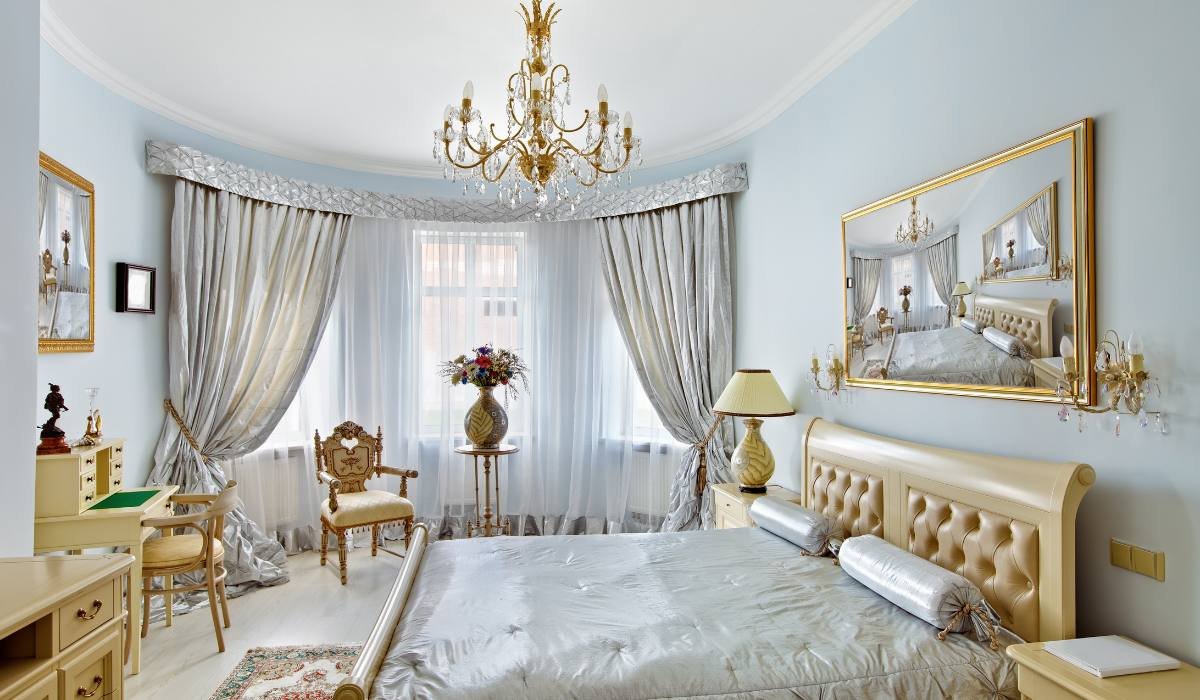In the books of design history, few movements have captured the imagination quite like Art Deco. This bold and distinctive style, born in the early 20th century, took the world by storm with its daring geometric forms, luxurious materials and unabashed embrace of modernity. From the iconic skyscrapers that graced the skylines of major cities to the exquisite jewellery and furnishings adorning the homes of the elite, Art Deco left an indelible mark on the era, transcending mere aesthetics to become a symbol of progress and optimism. In this comprehensive article, we’ll delve into the captivating world of Art Deco, tracing its history, exploring its defining characteristics and showcasing how this enduring style can be seamlessly incorporated into contemporary homes, adding a touch of timeless elegance and sophistication.
See also: All about bibliophilic design
What is Art Deco?
Art Deco is a distinctive design style that emerged in the 1920s and reached its peak during the 1930s. Characterised by its bold geometric shapes, streamlined forms and lavish use of materials like stainless steel, chrome and exotic woods, Art Deco embodied the spirit of progress and modernity that defined the era. This style rejected the ornate and intricate designs of the past, embracing a new visual language that celebrated industrialization, technology and the machine age.
The history and origins of Art Deco
The origins of Art Deco can be linked to the Exposition Internationale des Arts Décoratifs et Industriels Modernes, which took place in Paris in 1925. This landmark event served as a showcase for the innovative and forward-thinking design concepts that would come to define the Art Deco movement. Influenced by various artistic movements such as Cubism, Fauvism and Art Nouveau, as well as ancient Egyptian and Mayan motifs, Art Deco quickly gained popularity among architects, designers and artists who were seeking a new visual language to express the spirit of the modern age.
The rise of Art Deco in the 1920s and 1930s
As the Art Deco style gained traction, it found expression in a wide range of mediums, from architecture and interior design to fashion, jewellery and even consumer products. Iconic structures like the Chrysler Building in New York City and the Strand Palace Hotel in London became enduring examples of Art Deco architecture, with their sleek lines, geometric ornamentation and daring use of materials.
In the realm of interior design, Art Deco style embraced bold colours, lavish materials and intricate patterns, creating spaces that exuded luxury and sophistication. Furniture pieces featured streamlined shapes, often adorned with exotic wood veneers and metallic accents, while textiles and wallpapers showcased vibrant geometric motifs and stylized floral designs.
Colours associated
Art Deco was never shy about embracing bold and vibrant colours. The palette was dominated by rich and opulent hues that reflected the era’s sense of indulgence and glamour. Some of the most iconic colours associated with Art Deco include:
- Deep jewel tones like emerald green, sapphire blue and amethyst purple
- Metallic shades like gold, silver and bronze
- Vivid primary colours like red, yellow and blue
- Striking contrasts of black and white
- Earthy tones like terracotta, ochre and sage
These colours were often used in striking combinations, creating a sense of drama and opulence that was quintessentially Art Deco.
Art Deco style designs for the home
Geometric wallpaper or wall panelling
Embrace the bold and graphic nature of Art Deco by incorporating geometric wallpaper or wall panelling into your interior design. These patterns can add a sense of depth and movement to any space, while also serving as a focal point.
Advantages: It creates a visually striking and unique aesthetic, adds texture and interest to walls.
Disadvantages: Can be overwhelming in smaller spaces, may require professional installation.
Maintenance: Regular dusting and occasional spot cleaning for wallpaper, proper sealing for wall panelling.
Streamlined furniture with metallic accents
Art Deco furniture was characterised by its sleek, streamlined shapes and the use of metallic accents like chrome or brass. Incorporating these pieces into your home can add a touch of Art Deco glamour and sophistication.
Advantages: Timeless and elegant, durable materials, easy to clean and maintain.
Disadvantages: Can be expensive, may feel too cold or formal in some spaces.
Maintenance: Regular dusting and polishing of metallic accents, spot cleaning for upholstery.
Stained glass or leaded glass accents
Stained glass and leaded glass were popular elements in Art Deco design, often used in windows, doors and decorative panels. These accents can add a touch of opulence and a sense of movement to any space.
Advantages: Stunning visual impact, can create a focal point and allows natural light to filter through.
Disadvantages: Can be expensive, may require professional installation and can be fragile.
Maintenance: Regular cleaning with appropriate glass cleaners, careful handling.
Sunburst or Stepped Motifs
The sunburst and stepped motifs were iconic Art Deco designs, often used in wall decor, lighting fixtures and architectural details. Incorporating these elements into your home can add a touch of classic Art Deco style.
Advantages: Versatile and can be incorporated into various elements, creates visual interest and depth.
Disadvantages: Can feel dated or overwhelming if overused, may require custom work.
Maintenance: Regular dusting and cleaning, proper care for materials used.
Luxurious materials and finishes
Art Deco was all about indulgence and opulence, often incorporating luxurious materials like marble, exotic woods and chrome. Incorporating these materials and finishes into your home can add a touch of Art Deco glamour.
Advantages: Timeless and elegant, durable and long-lasting, can increase perceived value.
Disadvantages: Can be expensive, may require professional installation and maintenance.
Maintenance: Regular cleaning and polishing, proper sealing and care for porous materials.
The Art Deco style, with its bold and daring aesthetic, continues to captivate designers, architects and homeowners alike, nearly a century after its inception. This timeless moment, born out of a spirit of modernity and progress, has left an indelible mark on the world of design, transcending the boundaries of time and trends.
FAQs
What was the inspiration behind the Art Deco style?
The Art Deco style drew inspiration from various sources, including Cubism, Fauvism, Art Nouveau and ancient Egyptian and Mayan motifs. It was also influenced by the industrial and technological advancements of the early 20th century.
Is Art Deco still popular in modern interior design?
Yes, Art Deco has experienced a resurgence in popularity in recent years, with many designers and homeowners embracing its bold and glamorous aesthetic. Elements like geometric patterns, metallic accents and luxurious materials are being incorporated into contemporary spaces.
What are some of the most iconic examples of Art Deco architecture?
Some of the most famous Art Deco buildings include the Chrysler Building and Empire State Building in New York City, the Strand Palace Hotel in London and the Basilica of the Sacred Heart in Brussels.
Can Art Deco elements be combined with other design styles?
Absolutely. Art Deco elements can be seamlessly integrated with various design styles, from mid-century modern to contemporary minimalism. The key is to strike a balance and choose complementary pieces and accents.
Are there any specific colours that are considered quintessentially Art Deco?
Yes, the Art Deco colour palette is known for its bold and rich hues, including jewel tones like emerald green, sapphire blue and amethyst purple, as well as metallic shades like gold, silver and bronze.
How can I incorporate Art Deco style into my home on a budget?
You can introduce Art Deco elements into your home without breaking the bank by incorporating geometric patterns through wallpaper or wall decals, using metallic accents like vases or lamps, or adding a few Art Deco-inspired furniture pieces gradually.
What are some tips for maintaining Art Deco furniture and decor?
To maintain Art Deco furniture and decor, regular dusting and polishing are essential. Metallic accents should be cleaned with appropriate solutions to prevent tarnishing. Upholstered pieces may require professional cleaning or spot treatment for stains.
Can Art Deco style be integrated into modern smart home technology?
Yes, Art Deco style can be seamlessly integrated with modern smart home technology. For example, you can incorporate geometric patterns or metallic accents into smart home devices or use voice commands to control lighting and create an Art Deco-inspired ambiance.
| Got any questions or point of view on our article? We would love to hear from you. Write to our Editor-in-Chief Jhumur Ghosh at [email protected] |

Upasana Mandhata, currently in her final year of Law, is pursuing a BA LLB Degree at VIT University Chennai. Her interest in content creation dates back to her school and college years when she discovered a writing passion. Drawing from personal experiences, her writing style has been shaped by her journey and encounters. She enjoys experimenting with new recipes, painting, or swimming while clocking out of work time.











